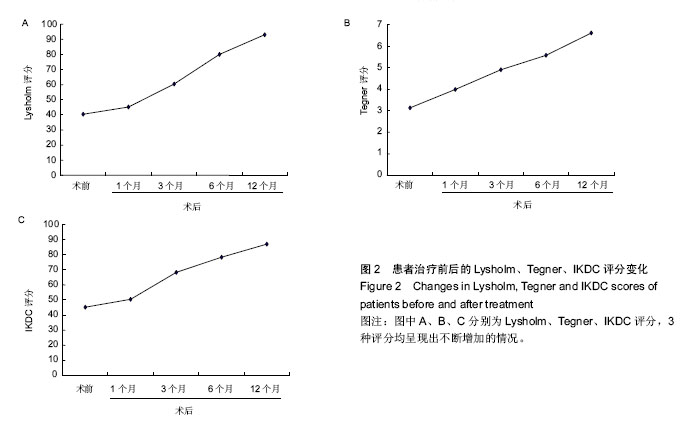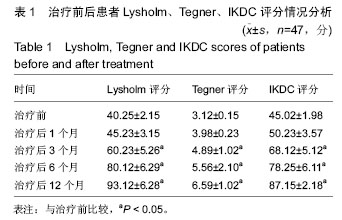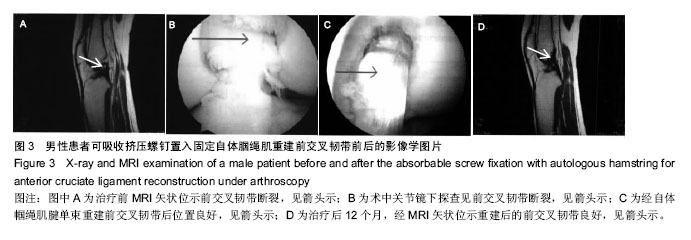| [1]岳建明,王庆锋,温鹏,等.关节镜下Rigidfix系统及可吸收挤压螺钉固定自体腘绳肌腱重建前交叉韧带的临床疗效观察[J].宁夏医科大学学报,2011,33(11):1103-1105.
[2]孙磊,宁廷民,田敏,等.关节镜下自体四股腘绳肌腱重建膝前交叉韧带[J].中华创伤杂志,2005,21(5):336-340.
[3]金鑫,夏长所,肖程程,等.关节镜下Edobutton联合Intrafix与可吸收挤压螺钉固定自体腘绳肌腱重建前交叉韧带的疗效对比[J].中华临床医师杂志(电子版), 2015,9(8): 1292-1297.
[4]Persson A,Fjeldsgaard K,Gjertsen JE,et al.Increased risk of revision with hamstring tendon grafts compared with patellar tendon grafts after anterior cruciate ligament reconstruction: A study of 12,643 patients from the norwegian cruciate ligament registry, 2004-2012.Am J Sports Med.2014;42(2):285-291.
[5]Choi JY,Ha JK,Kim YW,et al.Relationships among tendon regeneration on MRI, flexor strength, and functional performance after anterior cruciate ligament reconstruction with hamstring autograft.Am J Sports Med.2012;40(1):152-162.
[6]Williams RJ 3rd,Hyman J,Petrigliano F,et al.Anterior cruciate ligament reconstruction with a four-strand hamstring tendon autograft. Surgical technique.J Bone Joint Surg Am. 2005;87 Suppl 1(Pt 1):51-66.
[7]白正武,朱本珂,张明,等.移植物不同固定方式对自体腘绳肌腱重建膝前交叉韧带术后股骨骨道影响的对比研究[J].中国矫形外科杂志,2010,18(2):106-109.
[8]Takeda Y,Kashiwaguchi S,Matsuura T,et al.Hamstring muscle function after tendon harvest for anterior cruciate ligament reconstruction: evaluation with T2 relaxation time of magnetic resonance imaging.Am J Sports Med.2006;34(2):281-288.
[9]Lo YP,Hsu KY,Chen LH,et al.Simultaneous arthroscopic reconstruction of the anterior and posterior cruciate ligament using hamstring and quadriceps tendon autografts.J Trauma. 2009;66(3): 780-788.
[10]孙磊,宁志杰,田敏,等.关节镜下四股腘绳肌腱单束重建膝关节后交叉韧带[J].中国矫形外科杂志, 2005,13(24): 1854-1857.
[11]何爱珊,廖威明,付明,等.关节镜下自体腘绳肌腱重建膝关节前交叉韧带[J].中国骨伤,2008,21(3):167-169.
[12]李卫平,陈仲,宋斌,等.关节镜下横杆式固定重建膝前十字韧带的中期疗效观察[J].中华骨科杂志, 2013,33(8): 820-825.
[13]李钦宗,周红星,张保健,等.微骨折术对前交叉韧带重建术后腱骨愈合影响的初步临床研究[J].中国内镜杂志, 2013, 19(10):1095-1097.
[14]李哲海,武宇赤,张霄雁,等.关节镜下自体腘绳肌腱重建交叉韧带[J].内蒙古医学杂志, 2008,40(10): 1176-1178.
[15]朱云华,王晓东,李玉前,等.膝关节镜下自体腘绳肌腱单束等长重建前交叉韧带疗效分析[J].南通大学学报(医学版), 2014,(2):96-98.
[16]闫宇旺,贾岩波,刘国亭,等.自体肌腱重建膝关节前交叉韧带股骨侧Rigidfix固定疗效分析[J].内蒙古医学杂志, 2015, 47(8):941-944.
[17]刘红光,陈述祥,赵崇达,等.膝关节镜下自体腘绳肌腱和同种异体肌腱重建前交叉韧带对比观[C].//全军第四届关节镜暨运动医学第五届上颈椎外科国际研讨会论文汇编, 2007:68-71.
[18]Biscarini A,Botti FM,Pettorossi VE,et al.Selective contribution of each hamstring muscle to anterior cruciate ligament protection and tibiofemoral joint stability in leg-extension exercise: A simulation study.Eur J Appl Physiol.2013;113(9):2263-2273.
[19]Tashiro T,Kurosawa H,Kawakami A,et al.Influence of medial hamstring tendon harvest on knee flexor strength after anterior cruciate ligament reconstruction. A detailed evaluation with comparison of single- and double-tendon harvest.Am J Sports Med. 2003;31(4): 522-529.
[20]樊强,朱建林,姜振奎,等.关节镜下双侧腘绳肌腱同时重建膝关节前后交叉韧带[J].实用骨科杂志, 2010,16(2): 132-134.
[21]Carofino B,Fulkerson J.Medial hamstring tendon regeneration following harvest for anterior cruciate ligament reconstruction: fact, myth, and clinical implication.Arthroscopy.2005;21(10):1257-1265.
[22]刘红光,陈述祥,赵崇达,等.膝关节镜下自体腘绳肌腱和同种异体肌腱移植重建前交叉韧带对比观察[J].中国骨伤, 2008,21(4):267-269.
[23]Jansson KA,Linko E,Sandelin J,et al.A Prospective Randomized Study of Patellar versus Hamstring Tendon Autografts for Anterior Cruciate Ligament Reconstruction.Am J Sports Med.2003;31(1):12-18.
[24]罗高斌,吴昊,廖军,等.关节镜下可吸收螺钉固定胭绳肌腱重建膝后交叉韧带[J].中国现代医学杂志, 2010,20(20): 3135-3137.
[25]Matsumoto A,Yoshiya S,Muratsu H,et al.A comparison of bone-patellar tendon-bone and bone-hamstring tendon-bone autografts for anterior cruciate ligament reconstruction.Am J Sports Med.2006;34(2):213-219.
[26]王洪,杨述华,邵增务,等.关节镜下可吸收螺钉固定腘绳肌重建膝后交叉韧带后疗效评价[C].//第四届中国武汉国际微创外科学术研讨会论文集,2009:646-649.
[27]胡慈贞,阮庆平,沈锋,等.LARS人工韧带与自体腘绳肌腱重建前交叉韧带的康复护理及疗效比较[J].中国实用护理杂志,2012,28(23):28-30.
[28]Gill TJ,DeFrate LE,Wang C,et al.The biomechanical effect of posterior cruciate ligament reconstruction on knee joint function. Kinematic response to simulated muscle loads.Am J Sports Med.2003;31(4):530-536.
[29]张华,李贵山.关节镜下交叉韧带重建手术22例临床分析[J].中华实用诊断与治疗杂志,2015,29(8):800-801.
[30]Ahmad CS,Clark AM,Heilmann N,et al.Effect of gender and maturity on quadriceps-to-hamstring strength ratio and anterior cruciate ligament laxity.Am J Sports Med. 2006;34(3):370-374.
[31]Ritchie JR,Parker RD.Graft selection in anterior erueiate ligament revision surgery.Clin Orthop.1996; 325:65-67.
[32]王洪,杨述华,邵增务,等.关节镜下可吸收螺钉固定胭绳肌重建膝后交叉韧带后疗效评价[C].//第二届泛长江流域骨科新进展研讨会论文集,2008:189-192.
[33]葛生浩,包诗勇,袁显群,等.经关节镜四股腘绳肌腱重建膝关节前交叉韧带疗效的观察[J].中国实用医刊,2014, 41(17): 64-65.
[34]Brand Jr JC,Nyland J,Caborn DNM,et al.Soft-tissue interference fixation: bioabsorbable screw versus metal screw.Arthroscopy.2005;21(8):911-916.
[35]王立晖,李卫平,宋斌,等.关节镜下前交叉韧带单束与“人”字形重建远期疗效的比较[J].中国组织工程研究,2013, 17(18):116-123.
[36]陈超鹏,付红亮.关节镜下可吸收挤压螺钉固定腘绳肌重建后交叉韧带[J].实用医学杂志,2011,27(9):1709.
[37]Withrow TJ,Huston LJ,Wojtys EM,et al.The relationship between quadriceps muscle force, knee flexion, and anterior cruciate ligament strain in an in vitro simulated jump landing.Am J Sports Med.2006; 34(2):269-274.
[38]俸志斌.关节镜下自体肌腱同时联合重建膝前、后交叉韧带的临床研究[J].微创医学,2011,6(4):315-317.
[39]魏立伟,王志伟,权松涛,等.关节镜下重建前交叉韧带34例疗效分析[J].泰山医学院学报,2013,34(3):183-184. |
.jpg)



.jpg)
.jpg)